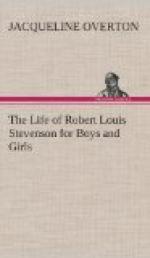They grew most enthusiastic over the idea and told one another how they would furnish their “water villa” with easy chairs, pipes, and tobacco, and the bird and the dog should go along too.
By the time Fontainebleau was reached they had planned trips through all the canals of Europe. The idea took the artists’ fancy also, and a group of them actually purchased a canal-boat called The Eleven Thousand Virgins of Cologne. Furnishing a water villa, however, was more expensive than they had foreseen, and she came to a sad end. “’The Eleven Thousand Virgins of Cologne’ rotted in the stream where she was beautified ... she was never harnessed to the patient track-horse. And when at length she was sold, by the indignant carpenter of Moret, there was sold along with her the Arethusa and the Cigarette ... now these historic vessels fly the tricolor and are known by new and alien names.”
In 1873 Stevenson planned to try for admission to the English bar instead of the Scottish and went to London to take the examination. But his health, which had been rather poor, became worse, and on reaching London the doctor ordered him to Mentone in the south of France, where he had been before as a boy.
There he spent his days principally lying on his back in the sun reading and playing with a little Russian girl with whom he struck up a great friendship. His letters to his mother were full of her sayings and doings. He was too ill to write much, although one essay, “Ordered South,” was the outcome of this trip, the only piece of writing in which he ever posed as an invalid or talked of his ill health.
At the end of two months he improved enough to return to Edinburgh, but gave up the idea of the English bar. His illness and absence seemed to have smoothed out some of the difficulties at home, and after he returned things went happier in every way.
On July 14, 1875, he passed his final law examinations, and was admitted to the Scottish bar. He was now entitled to wear a wig and gown, place a brass plate with his name upon the door of 17 Heriot Row, and “have the fourth or fifth share of the services of a clerk” whom it is said he didn’t even know by sight. For a few months he made some sort of a pretense at practising, but it amounted to very little. Gradually he ceased paying daily visits to the Parliament House to wait for a case, but settled himself instead in the room on the top floor at home and began to write, seriously this time—it was to be his life-work from now on—and the law was forgotten.
His first essays were published in the Cornhill Magazine and The Portfolio under the initials R.L.S., which signature in time grew so familiar to his friends and to those who admired his writings it became a second name for him, and as R.L.S. he is often referred to.
He was free now to roam as he chose and spent much time in Paris with Bob. The life there in the artists’ quarter suited him as well as it had at Fontainebleau. There, among other American artists, he was associated with Mr. Will Low, a painter, whom he saw much of when he came to New York.




